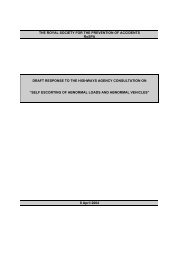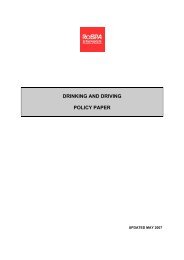RoSPA Young Drivers at Work Report
RoSPA Young Drivers at Work Report
RoSPA Young Drivers at Work Report
Create successful ePaper yourself
Turn your PDF publications into a flip-book with our unique Google optimized e-Paper software.
Chapter 2<br />
Methodology<br />
The research employed a mixed methodology approach,<br />
consisting of three strands:<br />
1) A questionnaire for employers and managers of young<br />
people who drive for work<br />
2) In-depth interviews with employers and managers<br />
3) Focus group interviews with the young people<br />
themselves who drive for work<br />
Each component of the methodology was piloted and<br />
redrafting was undertaken where necessary. There were<br />
several stages of piloting. Initially several meetings were<br />
held with individual employers of different sizes and<br />
discussions were based around their experiences and<br />
thoughts about young <strong>at</strong>-work drivers.<br />
The result of this was the production of an initial question<br />
set for both the questionnaire and the in depth interview.<br />
These documents were further refined with consult<strong>at</strong>ion<br />
from key project stakeholders.<br />
The questionnaire was trialled on a group of 15 employers<br />
<strong>at</strong>tending the Safety and Health Expo 2008 <strong>at</strong> the N<strong>at</strong>ional<br />
Exhibition Centre in Birmingham. Three of those employers<br />
also particip<strong>at</strong>ed in pilot telephone interviews which<br />
produced the final interview guide.<br />
The questionnaire was also trialled internally to<br />
check usability.<br />
D<strong>at</strong>a was then collected over a period of 13 weeks, from<br />
September 30, 2008 to January 7, 2009. None of the pilot<br />
d<strong>at</strong>a has been included in the final analysis.<br />
The questionnaire consisted of closed and open ended<br />
questions. Likert scales were also included to measure<br />
employers’ <strong>at</strong>titudes.<br />
The questionnaire yielded 407 responses. These were<br />
entered into a d<strong>at</strong>abase from which the answers were<br />
descriptively analysed and cross-tabul<strong>at</strong>ed. Percentages<br />
were rounded up to the nearest whole number.<br />
A total of 47 in-depth telephone interviews were<br />
conducted with employers and managers. Interviewees<br />
were sampled from the same frame as the questionnaire<br />
respondents and some duplic<strong>at</strong>ion occurred.<br />
The interviews followed a general semi-structured<br />
interview guide with open-ended questions, and lasted<br />
approxim<strong>at</strong>ely 45 minutes each. Interviewees were asked if<br />
they were happy to be recorded and both their written and<br />
verbal consent was obtained. Not all interviews were<br />
recorded but those th<strong>at</strong> were, were transcribed by the<br />
interviewer. Interviewees were informed th<strong>at</strong> their d<strong>at</strong>a<br />
would be kept confidential and also anonymised.There was<br />
some follow-up correspondence by the interviewer to<br />
check the accuracy of inform<strong>at</strong>ion.<br />
The qualit<strong>at</strong>ive in-depth interviews provided the<br />
opportunity for employers to expand on responses and to<br />
introduce points not covered.<br />
Using a telephone interview method saved on travel costs<br />
and allowed collection of a gre<strong>at</strong>er amount of d<strong>at</strong>a within<br />
a limited time scale. The telephone interviews proved<br />
convenient for employers but did succumb to workplace<br />
distractions and in some cases, mobile telephone reception.<br />
Five focus group interviews were carried out in which a<br />
total of 21 males and three females particip<strong>at</strong>ed. All but<br />
one of the participants were aged between 17 and 24<br />
years. One participant was aged 28 years. The sample<br />
groups were selected to represent a range of circumstances<br />
and conditions encountered in driving for work.<br />
These encompassed driving large vans in both urban and<br />
rural environments, oper<strong>at</strong>ing various vehicles on site, and<br />
driving emergency response vehicles. The focus group<br />
members were either apprentices/trainees, or very newly<br />
qualified in their profession.<br />
The focus groups were recorded with consent,<br />
and transcribed.<br />
The combin<strong>at</strong>ion of these three methods meant rich and<br />
triangul<strong>at</strong>ed d<strong>at</strong>a.<br />
Sample<br />
The questionnaire survey was open to all employers and<br />
volunteer recruiters of 17-24 year olds who drive for work<br />
purposes (paid and un-paid work). The questionnaire was<br />
distributed electronically as well as in hard copy to a range<br />
of companies and organis<strong>at</strong>ions through a number of<br />
different d<strong>at</strong>abases. One disadvantage with this method<br />
was th<strong>at</strong> it is not known how many people received the<br />
survey and therefore neither response r<strong>at</strong>e nor non-response<br />
bias could be calcul<strong>at</strong>ed. The sample was non-random and<br />
non-str<strong>at</strong>ified. The questionnaire was distributed through<br />
the following channels:<br />
<strong>Young</strong> <strong>Drivers</strong> <strong>at</strong> <strong>Work</strong> <strong>Report</strong><br />
5
















